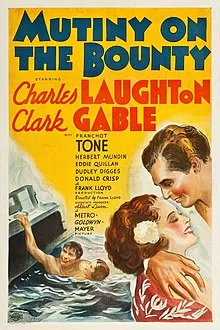
The 1935 film Mutiny on the Bounty is an American Technicolor epic historical drama directed by Lewis Milestone and starring Clark Gable, Trevor Howard, and Richard Harris. It tells a heavily fictionalized story of the real-life mutiny led by Fletcher Christian against William Bligh, captain of HMAV Bounty, in 1789.
The film was partly shot on location in the South Pacific and was the first motion picture filmed in the Ultra Panavision 70 widescreen process.
Plot
The 1935 film tells the story of Captain Bligh and Fletcher Christian aboard HMS Bounty for a voyage to Tahiti. Bligh proves to be a brutal tyrant, and after six pleasant months on Tahiti, Christian leads the crew to mutiny on the homeward voyage. Even though Byam takes no part in the mutiny, he must defend himself against charges that he supported Christian.
Trailer
Cast
- Charles Laughton as Captain Bligh
- Clark Gable as Fletcher Christian
- Franchot Tone as Byam
- Herbert Mundin as Smith
- Eddie Quillan as Ellison
- Dudley Digges as Bacchus
- Donald Crisp as Burkitt
- Henry Stephenson as Sir Joseph Banks
- Francis Lister as Capt. Nelson
- Spring Byington as Mrs. Byam
- Movita Castaneda as Tehani (as Movita)
- Mamo Clark as Maimiti (as Mamo)
- Byron Russell as Quintal
- David Torrence as Lord Hood
- John Harrington as Mr. Purcell
- Douglas Walton as Stewart
- Ian Wolfe as Maggs
- DeWitt Jennings as Fryer
- Ivan F. Simpson as Morgan (as Ivan Simpson)
- Vernon Downing as Hayward
- Bill Bambridge as Hitihiti (as William Bambridge)
- Marion Clayton as Mary Ellison
- Stanley Fields as Muspratt
- Wallis Clark as Morrison
- Crauford Kent as Lt. Edwards (as Craufurd Kent)
- Pat Flaherty as Churchill
- Alec Craig as McCoy
- Hal LeSueur as Millard
- Harry Allen as Wherryman (uncredited)
- Dick Winslow as Tinkler
- Charles Irwin as Thompson
Director: Frank Lloyd
Writer: Talbot Jennings, Jules Furthman, Carey Wilson
Box Office Gross: $4.46 million (rentals)
Distributor: Metro-Goldwyn-Mayer
Genre: Adventure
Release Date (Theaters): Nov 8, 1935
Release Date (Streaming): Nov 21, 2016
Themes & Reception
The central theme in most versions of Mutiny on the Bounty revolves around the question of whether the mutiny was the fault of Captain Bligh or Fletcher Christian. The 1935 film, despite historical inaccuracies, was a huge box office success, becoming the highest-grossing film of 1935 and one of MGM's biggest hits of the 1930s.
Challenges Faced
The production of the film Mutiny on the Bounty faced several challenges. These included script issues, delays in the arrival of the ship, conflicts among the actors, problems with local authorities, and bad weather during filming in Tahiti.
The film was a large undertaking, filmed in color and widescreen format on location in Tahiti, and featured a reproduction of the ship that was built in Nova Scotia. The arrival of a large motion picture production was also bound to have an impact on local conditions.
Styles & techniques
The film Mutiny on the Bounty was the first motion picture filmed in the Ultra Panavision 70 widescreen process, which allowed for a wider aspect ratio and greater visual detail. The film also features stunning location shots in Tahiti, showcasing the natural beauty of the island and its people.
The cinematography by Robert Surtees was praised for its use of color and lighting to create a sense of mood and atmosphere. The film also features impressive set design and costumes, which were designed to be historically accurate and visually striking.
The use of close-ups and medium shots during dialogue scenes helped to create a sense of intimacy and tension between the characters. Overall, the film's visual style and techniques were innovative for their time and helped to create a sense of epic grandeur and realism.
Setting
The film Mutiny on the Bounty was partly shot on location in the South Pacific, adding authenticity to the setting. The use of the Ultra Panavision 70 widescreen process allowed for a visually stunning portrayal of the natural beauty of the South Pacific.
The film's setting and visual style aimed to capture the grandeur and allure of the exotic locations, contributing to the overall epic historical drama.
Trivia
The 1935 film Mutiny on the Bounty has left an indelible mark on cinema history, captivating audiences since its release. The film's attention to historical accuracy and commitment to recreating the settings and details of the 18th-century maritime world has been widely praised.
The movie's climactic courtroom scene is considered a highlight, adding an extra layer of drama and tension to the narrative. Following the film's release, public interest in the real-life mutiny and the history of the HMS Bounty increased significantly.
The success of the film inspired a global fascination with maritime history, influencing subsequent films and literature of the genre. The phrase "mutiny on the bounty" has since been used to describe any rebellion or uprising against authority, showcasing the enduring legacy of the film.
Fun Fact
A fun fact about the mutiny on the Bounty is that the crew's reluctance to leave Tahiti, where they had been beguiled by the charms of the Tahitian women, played a role in the events leading to the mutiny. The allure of Tahiti, coupled with the harsh conditions on the ship, contributed to the crew's discontent, ultimately leading to the mutiny led by Fletcher Christian in April 1789.